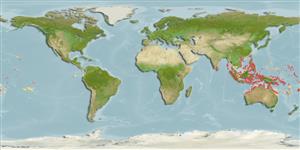Common names from other countries
>
Gobiiformes (Gobies) >
Gobiidae (Gobies) > Gobiinae
Etymology: Eviota: No etymology given, suggested by Christopher Scharpt: from Latin 'eu' for 'true' and 'iota' for anything very small, in combination 'truly very small' referring to it as being the smallest vertebrate at the time it has benn described by Jenkins (thus, making the suggestion by Scharpt plausible..
More on author: Whitley.
Environment: milieu / climate zone / depth range / distribution range
Οικολογία
Θαλασσινό(ά) Υφαλόφιλο(α); εύρος βάθους ? - 12 m (Ref. 86942). Tropical; 23°N - 24°S
Western Pacific: southwestern Thailand to Vanuatu, north to southern Taiwan, south to the southern Great Barrier Reef; including New Caledonia, Vanuatu and Tonga.
Μέγεθος / Βάρος / Age
Maturity: Lm ? range ? - ? cm
Max length : 2.4 cm SL αρσενικό/απροσδιόριστο; (Ref. 1602)
Short description
Κλείδες προσδιορισμού | Μορφολογία | Μορφομετρία
Ραχιαίες άκανθες (συνολικά) : 7; Μαλακές ραχιαίες ακτίνες (συνολικά) : 8 - 10; Εδρικές άκανθες: 1; Μαλακές εδρικές ακτίνες: 7 - 9. Characterized by semi-translucent grey or greenish color with intense dark spots on head; scale margins narrow brown to reddish; about six internal brown bars; base of pectoral fin with pair of dark brown spots; longitudinal scale series 23-25; ctenoid scales, absent on head, nape, breast and pectoral fin base; separated pelvic fins, thin membrane joining bases; depth of body 4.1-5.0 in SL (Ref. 90102).
Occurs at Belau's rock islands. Inhabits rubble and algal-covered patches of dead reef in 1-6 m (Ref 90102). Benthic (Ref. 75154). Feeds primarily on small invertebrates, also consumes detritus, contributing to a major trophic pathway on coral reefs. Spawning appears to be repeated on a regular cycle, semilunar or every 14 days (Ref. 116739).
Life cycle and mating behavior
Maturities | Αναπαραγωγή | Spawnings | Egg(s) | Fecundities | Προνύμφες
Myers, R.F., 1991. Micronesian reef fishes. Second Ed. Coral Graphics, Barrigada, Guam. 298 p. (Ref. 1602)
IUCN Red List Status (Ref. 130435)
CITES (Ref. 128078)
Not Evaluated
Threat to humans
Harmless
Human uses
Εργαλεία
Special reports
Download XML
Διαδικτυακές πηγές
Estimates based on models
Preferred temperature (Ref.
115969): 26.4 - 29.3, mean 28.7 (based on 2280 cells).
Phylogenetic diversity index (Ref.
82804): PD
50 = 0.5000 [Uniqueness, from 0.5 = low to 2.0 = high].
Bayesian length-weight: a=0.00708 (0.00333 - 0.01504), b=3.09 (2.92 - 3.26), in cm Total Length, based on LWR estimates for this (Sub)family-body shape (Ref.
93245).
Τροφικό Επίπεδο (Ref.
69278): 3.1 ±0.3 se; based on size and trophs of closest relatives
Ελαστικότητα (Ref.
120179): Υψηλό, ελάχιστος χρόνος για διπλασιασμό πληθυσμού < 15 μήνες (Preliminary K or Fecundity.).
Fishing Vulnerability (Ref.
59153): Low vulnerability (10 of 100).
